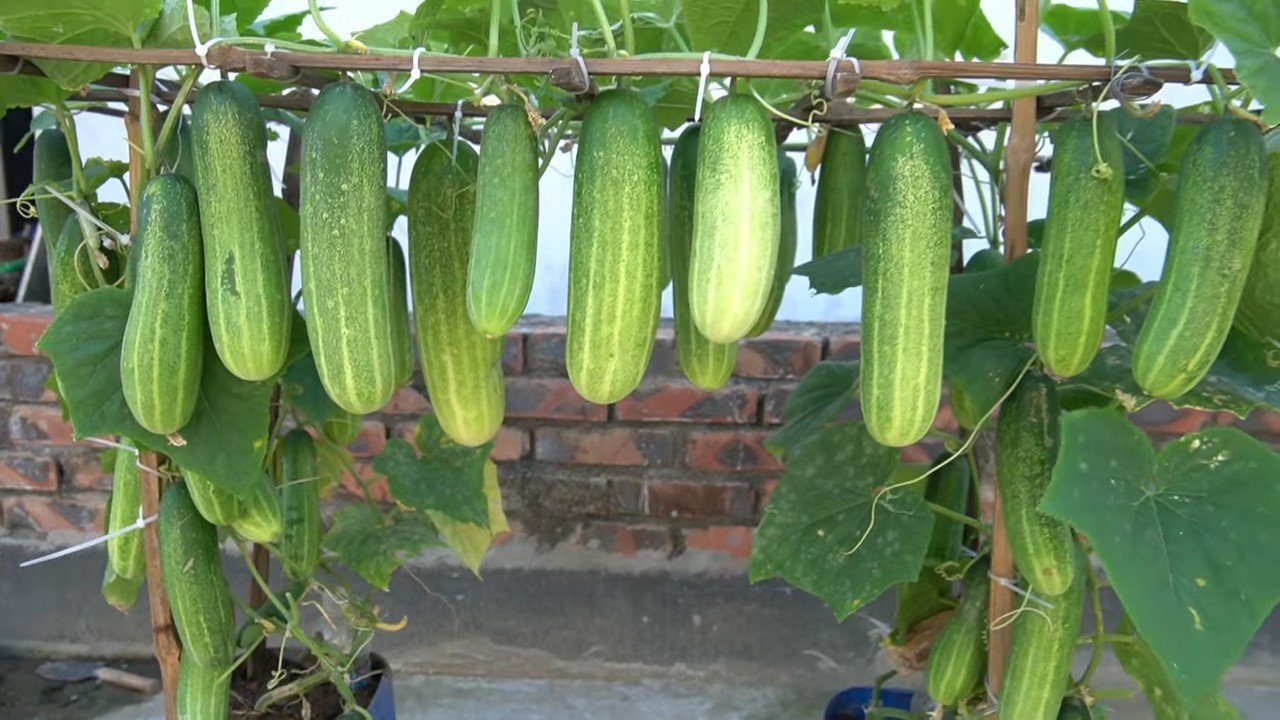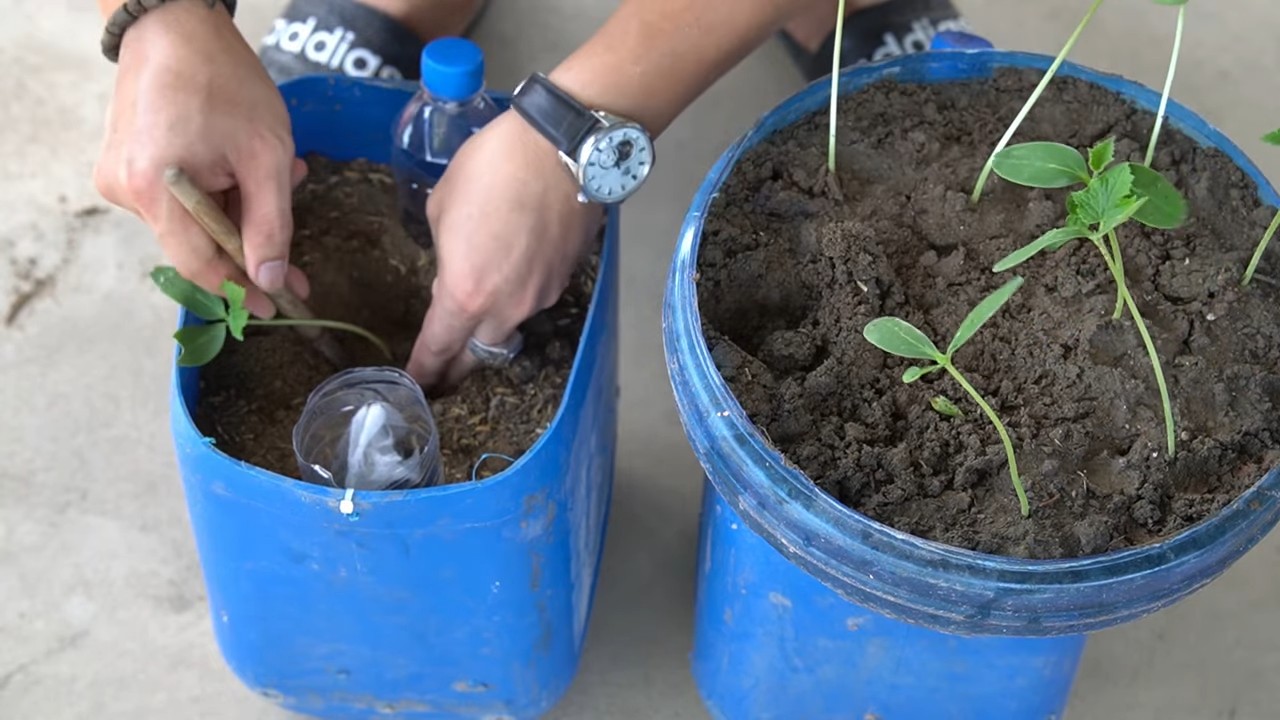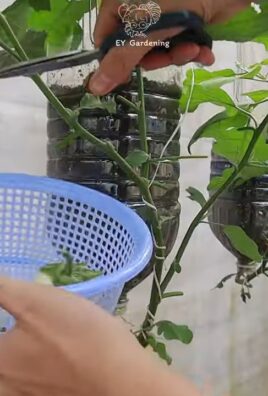Growing cucumbers in pots might seem like a challenge, especially if you’re short on space, but trust me, it’s totally achievable and incredibly rewarding! Imagine plucking fresh, crisp cucumbers right from your patio or balcony – that’s the magic we’re about to unlock together.
For centuries, cucumbers have been cultivated across various cultures, from ancient Egypt to the gardens of Greece and Rome. They were prized not only for their refreshing taste but also for their medicinal properties. Today, while we might not rely on them for healing as much, the joy of harvesting your own food remains a deeply satisfying connection to the earth.
But why bother with growing cucumbers in pots? Well, let’s face it, not everyone has a sprawling garden. Apartment dwellers, urbanites with limited outdoor space, and even those with mobility issues can still enjoy the pleasures of homegrown produce. Plus, container gardening offers greater control over soil quality, watering, and pest management. This DIY guide will equip you with all the insider tips and tricks you need to successfully grow delicious cucumbers, no matter how small your space. Get ready to roll up your sleeves and transform your balcony into a mini cucumber oasis!

Growing Cucumbers in Pots: A Comprehensive DIY Guide
Hey there, fellow gardening enthusiasts! I’m so excited to share my tried-and-true method for growing delicious, crisp cucumbers right in pots. Forget sprawling gardens – with a little know-how, you can enjoy a bountiful cucumber harvest even on a small balcony or patio. Let’s dive in!
Choosing the Right Cucumber Variety
Not all cucumbers are created equal, especially when it comes to container gardening. You’ll want to select varieties that are compact and bush-like, rather than those that vine aggressively. Here’s a breakdown of some of my favorite container-friendly cucumber types:
* Bush Champion: This is a classic choice for pots. It produces a good yield of standard-sized cucumbers on a compact plant.
* Spacemaster: As the name suggests, this variety is bred for small spaces. It’s a prolific producer of dark green cucumbers.
* Salad Bush: Perfect for snacking, Salad Bush cucumbers are small, sweet, and practically seedless.
* Patio Snacker: Another excellent choice for small spaces, Patio Snacker produces mini cucumbers that are perfect for salads or pickling.
* Picklebush: If you’re a fan of homemade pickles, Picklebush is the way to go. It yields a large crop of pickling-sized cucumbers.
Important Note: Always check the seed packet or plant label for specific information about the variety’s growth habit and space requirements.
Gathering Your Supplies
Before we get our hands dirty, let’s make sure we have everything we need. Here’s a checklist of essential supplies:
* Large Pot: This is crucial! Cucumbers need plenty of room for their roots to grow. I recommend a pot that’s at least 12 inches in diameter and 12 inches deep, but bigger is always better. A 5-gallon container is a good starting point.
* High-Quality Potting Mix: Don’t skimp on the potting mix! Use a well-draining mix specifically formulated for containers. Avoid using garden soil, as it can become compacted in pots and hinder drainage.
* Cucumber Seeds or Seedlings: Choose your desired cucumber variety and purchase seeds or seedlings from a reputable source.
* Trellis or Support: Even bush varieties benefit from some support, especially when they start producing heavy fruits. A small trellis, tomato cage, or even a sturdy stake will do the trick.
* Slow-Release Fertilizer: This will provide your cucumber plants with a steady supply of nutrients throughout the growing season.
* Watering Can or Hose: Cucumbers need consistent moisture, so make sure you have a reliable watering system.
* Gardening Gloves: Protect your hands from dirt and potential irritants.
* Optional:
* Mulch: Helps retain moisture and suppress weeds.
* Liquid Fertilizer: For an extra boost of nutrients during the growing season.
* Pest Control: Be prepared to deal with common cucumber pests like aphids and squash bugs.
Planting Your Cucumbers
Now for the fun part! Let’s get those cucumbers planted.
1. Prepare the Pot: Fill your pot with high-quality potting mix, leaving about an inch or two of space at the top.
2. Sowing Seeds (if starting from seed):
* Make small holes about 1 inch deep and 2-3 inches apart.
* Place 2-3 seeds in each hole.
* Cover the seeds with potting mix and gently water.
* Once the seedlings emerge and have a few true leaves, thin them out, leaving only the strongest seedling in each spot.
3. Transplanting Seedlings (if starting with seedlings):
* Gently remove the seedling from its container, being careful not to damage the roots.
* Dig a hole in the potting mix large enough to accommodate the root ball.
* Place the seedling in the hole and backfill with potting mix, gently firming the soil around the base of the plant.
4. Install Support: Insert your trellis, tomato cage, or stake into the pot near the center. This will provide support for the cucumber plant as it grows.
5. Water Thoroughly: Water the newly planted cucumbers thoroughly, ensuring that the soil is evenly moist.
6. Add Slow-Release Fertilizer: Sprinkle slow-release fertilizer around the base of the plant, following the instructions on the package.
7. Mulch (Optional): Apply a layer of mulch around the base of the plant to help retain moisture and suppress weeds.
Caring for Your Cucumber Plants
Once your cucumbers are planted, it’s important to provide them with the proper care to ensure a healthy and productive harvest.
1. Watering: Cucumbers need consistent moisture, especially during hot weather. Water deeply whenever the top inch of soil feels dry to the touch. Avoid overwatering, as this can lead to root rot. I usually water every day or every other day, depending on the weather.
2. Sunlight: Cucumbers need at least 6-8 hours of sunlight per day. Place your potted cucumbers in a sunny location where they will receive plenty of direct sunlight.
3. Fertilizing: In addition to the slow-release fertilizer you added at planting time, you can supplement with a liquid fertilizer every 2-3 weeks during the growing season. Choose a fertilizer that is high in phosphorus and potassium, which are essential for fruit production.
4. Pruning: While bush varieties don’t require extensive pruning, you can pinch off any suckers (small shoots that grow from the base of the plant) to encourage more fruit production.
5. Pest and Disease Control: Keep an eye out for common cucumber pests like aphids, squash bugs, and cucumber beetles. You can control these pests with insecticidal soap, neem oil, or by hand-picking them off the plants. Also, watch out for diseases like powdery mildew and downy mildew. Improve air circulation around the plants and avoid overhead watering to prevent these diseases. If necessary, you can treat with a fungicide.
6. Training: Gently guide the cucumber vines up the trellis or support as they grow. Use soft ties or clips to secure the vines to the support.
Harvesting Your Cucumbers
The moment you’ve been waiting for! Harvesting your cucumbers is the most rewarding part of the process.
1. Timing: Cucumbers are typically ready to harvest about 50-70 days after planting, depending on the variety. Check the seed packet or plant label for specific information about the harvest time.
2. Size: Harvest cucumbers when they reach the desired size for your chosen variety. Overripe cucumbers can become bitter and seedy.
3. Method: Use a sharp knife or pruning shears to cut the cucumber from the vine, leaving a small stem attached.
4. Frequency: Harvest cucumbers regularly to encourage continued fruit production. The more you harvest, the more the plant will produce.
Troubleshooting Common Problems
Even with the best care, you may encounter some challenges when growing cucumbers in pots. Here are some common problems and how to address them:
* Yellowing Leaves: This can be caused by a variety of factors, including overwatering, underwatering, nutrient deficiencies, or pests. Check the soil moisture and adjust your watering accordingly. Fertilize with a balanced fertilizer to address nutrient deficiencies. Inspect the plants for pests and treat as needed.
* Blossom End Rot: This is a condition where the blossom end of the cucumber becomes dark and sunken. It’s usually caused by calcium deficiency or inconsistent watering. Ensure that your potting mix contains adequate calcium and water consistently.
* Lack of Fruit Production: This can be caused by a lack of pollination, nutrient deficiencies, or stress. Hand-pollinate the flowers by transferring pollen from the male flowers to the female flowers. Fertilize with a fertilizer high in phosphorus and potassium. Protect the plants from extreme temperatures and stress.
* Pest Infestations: As mentioned earlier, cucumbers are susceptible to a variety of pests. Regularly inspect the plants for pests and treat as needed with insecticidal soap, neem oil, or by hand-picking them off the plants.
Extending the Growing Season
Want to enjoy cucumbers for even longer? Here are a few tips for extending the growing season:
* Start Seeds Indoors: Start your cucumber seeds indoors 4-6 weeks before the last expected frost. This will give you a head start on the growing season.
* Use Row Covers: Cover your cucumber plants with row covers to protect them from frost and cold temperatures.
* Choose Early-Maturing Varieties: Select cucumber varieties that mature quickly to maximize your harvest.
* Succession Planting: Plant cucumbers in succession, planting a new batch every 2-3 weeks, to ensure a continuous harvest throughout the growing season.
Growing cucumbers in pots is a rewarding and enjoyable

Conclusion
So, there you have it! Growing cucumbers in pots isn’t just a gardening trend; it’s a game-changer for anyone with limited space, a desire for fresh, homegrown produce, or simply a love for the satisfying crunch of a perfectly ripe cucumber. We’ve walked you through the essentials, from selecting the right variety and pot size to mastering the art of watering and providing essential support.
But why is this DIY trick a must-try? Because it empowers you to take control of your food source, even if you only have a balcony or a sunny patio. Imagine stepping outside and harvesting crisp, flavorful cucumbers whenever you need them. No more relying on store-bought options that may have traveled miles and lost their freshness. You’ll be enjoying the peak of flavor and nutrition, knowing exactly where your food came from and how it was grown.
Beyond the convenience and freshness, growing cucumbers in pots is also incredibly rewarding. Watching those tiny seeds sprout, the vines climb, and the cucumbers swell with juicy goodness is a truly magical experience. It connects you to nature in a tangible way and provides a sense of accomplishment that’s hard to beat.
And the best part? You can customize your cucumber-growing experience to suit your preferences. Want to add a touch of spice? Try growing a variety like ‘Spicy Salsa’. Prefer a sweeter cucumber? ‘Lemon Cucumber’ might be your perfect match. You can also experiment with different trellising methods, from simple bamboo stakes to elaborate DIY structures. Consider companion planting with herbs like basil or marigolds to deter pests and enhance the flavor of your cucumbers.
Don’t be afraid to experiment and find what works best for you. Gardening is a journey of learning and discovery, and there’s no right or wrong way to do it. The most important thing is to have fun and enjoy the process.
We’re confident that you’ll be amazed at how easy and rewarding it is to grow your own cucumbers in pots. So, grab your seeds, pots, and soil, and get ready to embark on a delicious and fulfilling gardening adventure.
Now, we want to hear from you! Have you tried growing cucumbers in pots before? What tips and tricks have you learned along the way? Share your experiences, photos, and questions in the comments below. Let’s create a community of cucumber-growing enthusiasts and inspire others to give it a try. Your insights could be invaluable to someone just starting out. Let’s all learn together how to maximize our yield and enjoy the freshest, most flavorful cucumbers possible. We can’t wait to see what you grow!
Frequently Asked Questions (FAQ)
What are the best cucumber varieties for growing in pots?
Choosing the right cucumber variety is crucial for success when growing in containers. Bush or compact varieties are generally the best choice, as they require less space and are well-suited to pot cultivation. Some excellent options include:
* **Bush Champion:** A classic bush variety that produces abundant yields of crisp, flavorful cucumbers.
* **Spacemaster:** As the name suggests, this variety is ideal for small spaces and produces medium-sized cucumbers.
* **Patio Snacker:** A compact variety that’s perfect for snacking and salads.
* **Picklebush:** Specifically bred for pickling, this variety produces small, uniform cucumbers that are perfect for preserving.
* **Lemon Cucumber:** A unique variety that produces round, yellow cucumbers with a mild, slightly sweet flavor.
When selecting a variety, consider your personal preferences and the size of your pots. Be sure to read the seed packet or plant label for specific information on plant size and growing requirements.
How big of a pot do I need for growing cucumbers?
The size of the pot is another important factor to consider. Cucumbers need ample space for their roots to grow and develop. A minimum pot size of 5 gallons is recommended, but a 10-gallon pot or larger is even better. The larger the pot, the more room the roots will have to spread out, resulting in a healthier and more productive plant.
Ensure that the pot has adequate drainage holes to prevent waterlogging, which can lead to root rot. You can also add a layer of gravel or pebbles to the bottom of the pot to improve drainage.
What kind of soil should I use for growing cucumbers in pots?
Cucumbers thrive in well-draining, nutrient-rich soil. A good potting mix is essential for providing the necessary nutrients and moisture retention. Avoid using garden soil, as it can be too heavy and compact for container gardening.
A high-quality potting mix that contains a blend of peat moss, perlite, and vermiculite is a good choice. You can also amend the potting mix with compost or aged manure to add extra nutrients.
How often should I water my cucumber plants in pots?
Watering is crucial for cucumber growth, especially in containers. Cucumbers need consistent moisture to produce healthy fruits. Water your plants deeply whenever the top inch of soil feels dry to the touch.
During hot, dry weather, you may need to water your plants daily or even twice a day. Be sure to water at the base of the plant to avoid wetting the foliage, which can increase the risk of fungal diseases.
Do cucumbers in pots need fertilizer?
Yes, cucumbers are heavy feeders and benefit from regular fertilization. Use a balanced fertilizer that’s specifically formulated for vegetables. You can also use a liquid fertilizer diluted according to the package instructions.
Fertilize your cucumber plants every two to three weeks throughout the growing season. Avoid over-fertilizing, as this can lead to excessive foliage growth and reduced fruit production.
How do I provide support for my cucumber plants in pots?
Cucumbers are vining plants and need support to climb. A trellis, stake, or cage can provide the necessary support. Install the support structure when you plant your cucumbers to avoid disturbing the roots later on.
Train the vines to climb the support structure by gently guiding them and tying them with soft twine or plant ties. Prune away any suckers or side shoots that develop below the first set of flowers to encourage more fruit production.
How do I deal with pests and diseases on my cucumber plants?
Cucumbers are susceptible to various pests and diseases, such as aphids, spider mites, cucumber beetles, and powdery mildew. Regularly inspect your plants for signs of infestation or disease.
If you spot any pests, you can try spraying them with insecticidal soap or neem oil. For diseases, you can try using a fungicide or removing the affected leaves.
Preventative measures are also important. Ensure good air circulation around your plants, avoid overwatering, and remove any dead or diseased leaves promptly.
When can I harvest my cucumbers?
The time to harvest your cucumbers will depend on the variety and your personal preferences. Generally, cucumbers are ready to harvest when they reach the desired size and color.
Harvest cucumbers regularly to encourage more fruit production. Use a sharp knife or pruners to cut the cucumbers from the vine, leaving a small stem attached.
Can I grow cucumbers indoors in pots?
Yes, you can grow cucumbers indoors in pots, but you’ll need to provide them with adequate light and warmth. Place your cucumber plants near a sunny window or under grow lights.
You’ll also need to pollinate the flowers manually, as there won’t be any bees or other pollinators indoors. Use a small paintbrush to transfer pollen from the male flowers to the female flowers.
What are some common problems when growing cucumbers in pots and how can I fix them?
Some common problems include yellowing leaves (often due to nutrient deficiency or overwatering), blossom end rot (caused by calcium deficiency), and pest infestations. Research the specific symptoms and causes to address the issue effectively. For example, adding calcium to the soil can help with blossom end rot, while adjusting watering habits can prevent yellowing leaves.




Leave a Comment